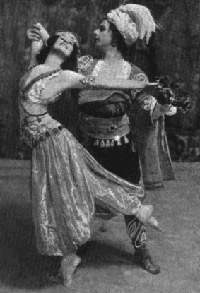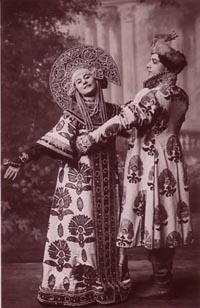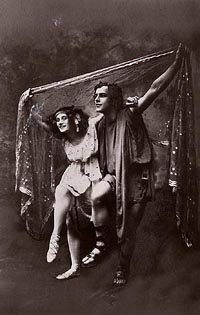
Mkhail Mordkin (1880-1944)
Mikhail Mikhailovich Mordkin, Russian dancer and teacher was born in Moscow, on December 9, 1880, into the family of the violinist of the Imperial Theatres. At the age of nine he entered Moscow Imperial Ballet School. Upon graduation in 1900, he was accepted to the company as a soloist. Very soon he was promoted to premier danseur, the highest rank in the company, and was featured in practically every leading role of the company's repertory, especially character parts. At the same time, in his early twenties, he began his teaching career at the Ballet School in Moscow, and first Russian private schools of dance and "plastic movement."
Even from his school days Mordkin established himself as an artist of an unusual expressiveness and passion. His technique, though, was frequently criticized as not purely classical and even shaky. But the classical technique itself was not Mordkin's concern. His ambition was to render deep emotions that went far beyond the limitations of ballet traditions of the time, and to make his technique serve purposes of portraying the character. In his performances he challenged dramatical standards of male dancing by enhancing his characters with deep feelings, rather than gallant manners, with detailed characterization, rather than beautiful posing and partnering.
Mikhail Mordkin was among the first Russian dancers to perform outside Russia. At the invitation of Kaiser Wilhelm he organized a short season in Berlin in the summer of 1908 (?), even before Diagileff's company opened its first season in Paris.
On the opening night of Ballets Russes in Paris in 1909, Mordkin danced the leading role in Michael Fokine's Le Pavillon d'Armide, and that same year, he appeared as Anna Pavlova's partner in London and United States. His personal success was equal to Pavlova's, and their partnership became one of the first ballet legends of the century.
During the next several years Mordkin organized two big tours to the United States with the All-Star Russian Imperial Ballet company; retired from and came back to the Imperial Theatres; staged a number of concert dances and small [UNK], opened his own private ballet school in Moscow, and continued performing regularly.
After the outbreak of the October Revolution Mordkin pursued the same activities: he danced at the Bolshoi Theatre, organized tours all over Russia, taught, staged ballets and concert dances, until in the 20s the growing chaos and famine made him look for ways of escaping Russia. In the fall of 1924, he finally managed to obtain permission to leave for a tour to the United States. He never went back.
In the United States, in 1927, Mikhail Mordkin opened Mordkin School of Dance, which offered "complete ballet training, mimo-drama classes, [and a] rehearsal group [that would] prepare ballets for performances." This group, the Mikhail Mordkin Ballet, was an outlet for advanced students (with Mikhail Mordkin himself dancing main character parts). On December 19, 1936, the company presented Sleeping Beauty, sponsored by the Woman's Club of Waterbury, Connecticut, with Lucia Chase and Dimitri Romanoff in the leading roles.
Plans for the student company became more ambitious. Advance Productions, with Lucia Chase as the major stockholder, was incorporated in March, 1937, to sponsor the company. The Mordkin Ballet began to tour nationwide with a small repertory of ballets choreographed by Mordkin. In 1938, the company was reorganized under Advanced Arts, Inc., with Rudolf Orthwine as president. Richard Pleasant managed the school and was later made secretary of the organization. A more professional Mordkin Ballet emerged, and dancers the caliber of Patricia Bowman, Nina Stroganova, Karen Conrad, Edward Caton, and Vladimir Dokoudovsky were hired.
The company continued to tour with Mordkin's ballets, however, many new ideas were developing. Chase and Pleasant began to plan a larger company, with more choreographers and dancers, and different artistic goals. In September of 1939, the nucleus of the Mordkin Ballet was reorganized into Ballet Theatre. Mikhail Mordkin was informed that he was no longer needed to teach or choreograph for the company, and only one of his ballets was ever produced by Ballet Theatre.
Mordkin returned to teaching at his Carnegie Hall studio.
Once his popularity as a dancer was enormous, he was one of the first male ballet stars of Russia, but it is as a teacher that he is best remembered in the United States. He possessed a "vivid personality" with the ability to "transmit something of the true spirit of the dance," and he tried to bring out special qualities in each of his students. He died in New York on July 15, 1944.
En las fotografías, con Anna Pavlova



